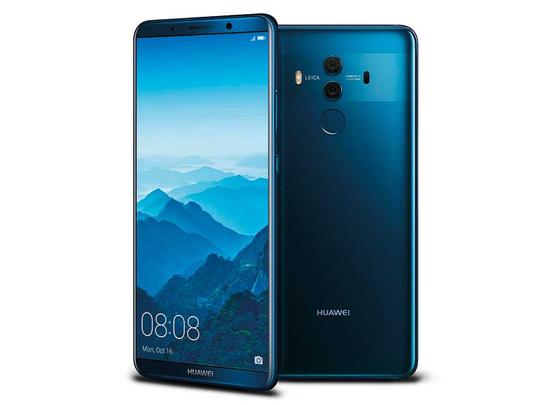
Dubai
Huawei’s Mate 10 Pro is a device that can stand at the top of the Android smartphones list with excellent features, better camera, bigger screen and longer battery life.
Huawei‘s flagship has a new design with an all-in Gorilla Glass 5 and curved edges at the back, complemented by brushed aluminium side walls. There is a unique shaded stripe pattern around the camera lens to add flair to the chassis.
The 6-inch AMOLED screen with an 18:9 screen ratio and minimal bezels give it more screen real estate (80.9% screen-to-body ratio) and the “Full HD+”, which means 2160x1080 resolution, the display offers realistic colours and details.
It houses 6GB of RAM and 128GB of storage but no microSD card support. It supports dual SIM card trays. It is powered by Oreo Android version and the skin is EMUI 8.0. The Pro is rated as being both dust- and water-resistant. It is also HDR10 certified.
The fingerprint scanner at the back is easy to reach, is extremely fast and has options such as swipe gestures to bring down the notification shade. The Mate 10 Pro weighs 178 grams, slightly heavier than Galaxy S8+ 173 grams and Pixel 2 XL’s 175 grams but lesser than Apple iPhone 8 Plus’ 202 grams.
The chip inside is the talk of the town as it packs a home-grown 2.4GHz Kirin 970 CPU and the first to feature artificial intelligence hardware, the Neural Processing Unit. Most of these run behind the scenes and are not obvious to the user.
Previous flagship chipsets from Huawei lagged in the GPU department. The new model has one of the most recent GPUs with all the power you need to run 3D graphic-rich games.
The EMUI software, for many years, has been the disadvantage for Huawei but the company has been improving with each version. The basic design language is the same, even though it’s now based on Android 8.0 Oreo version. The software design is the key area where it’s outshined by most of its competition. The EMUI 8 is the most refined version yet.
The AI right now works only with certain apps like camera and Microsoft’s Translator but Huawei is in the right direction. The AI element gives it a difference in a market where all the other Android phones have similar features. Unfortunately, a number of different things the AI can do on the device are relatively small at the moment.
The main thing that Huawei is using the AI is for object recognition and camera app. The camera app has benefits that it will select the best lighting for capturing photos. The best AI app preloaded on the Mate 10 is made by Microsoft and not by Huawei, the Microsoft translation app. The app when focused on a piece of the text will translate into other languages immediately. It is useful and very impressive for demonstrations as well. The 3.5mm headphone jack is missing from the device but there is dongle to connect the wired headphones. The IR blaster is the only thing of interest at the top of the phone. The bottom is pretty crowded with USB Type-C port, the primary speaker and mic. Huawei claims to have added machine learning algorithm to improve the performance of the device with time but I could not verify this as I need the device to be used for close to one year.
Motion control also plays a significant role on the Huawei Mate 9 Pro as it did on previous Huawei models. There are flip gestures, as well as picking up, tilting and even things like knuckle detection and drawing. All of those are extensively customisable to your liking as well.
Huawei has been teaming up with Leica for dual camera capabilities for the past 18 months on P10 and Mate 9 but Mate 10 Pro’s rear cameras have finally hit the top spot to match competitors like the Galaxy Note 8, iPhone X and Google Pixel 2.
The device has been rated at 97, the same level as iPhone X, according to DxOMark. DxOMark measures the performance of a camera’s lens and sensor. Higher scores indicate better overall camera quality.
That’s higher than the Samsung Galaxy Note 8’s score of 94 but lower than the Google Pixel 2’s 98. It is currently the second-best device in the market in terms of camera.
The camera is where the phone excels. The dual-lens Leica camera has matured into the second generation with 20MP monochrome and 12MP colour with f/1.6 aperture lens, OIS, 2xzoom, phase detection, four-in-one hybrid autofocus (phase/laser/contrast/depth-sensing), and dual-LED (dual tone) flash.
It is the first device in the market to have a wider aperture. The next will be LG’s yet-to-be-launched V30.
It is an outstanding smartphone for photography enthusiasts. It excels in still photography. In bright sunlight, the snaps deliver good exposure, even in tricky high-contrast scenes, where both shadow and highlight detail are well-preserved.
The AI scene detection automatically identifies the shooting scenarios and tweaks the settings for best results. It can identify the difference between a cat, a cupcake, trees, sunsets, mountains, food, people and text among others, and tweak the setting accordingly. It worked well in eight out of 10 tries. It is hard to say what kind of impact it had on the resulting photos.
Exposures in both indoor and very low-light conditions are excellent. It also displays a wide dynamic range in indoor pictures.
The dual lens produced very good snaps with decent lighting as well as in very low-light conditions when compared to single lens cameras. The images show accurate colours, high detail level and good dynamic range but the monochrome camera is the best.
There is also Pro mode for those who want to tweak things further. If you’re a photography fan you’ll likely find the Pro mode useful and enjoyable.
There are 13 different pre-programmed shooting modes when you swipe to the right, swiping left, you can control the resolution, picture size and different options.
When zooming, the Mate 10 uses the high 20MP resolution of its secondary monochrome sensor and computational imaging to capture a high-quality digital zoom image. With a 2x zoom factor, detail preservation is not quite as good as on other flagship devices.
With its Wide Aperture mode enabled, the Mate 10 Pro is capable of creating a bokeh effect with accurate depth estimation and good subject isolation. There are some artefacts visible under closer inspection, though, and some images taken in bright light show a degree of underexposure. The blur is not as aggressive as we’ve seen on some other devices such as iPhone X.
Scenes with motion are a little more challenging for the Mate 10 Pro, so if you’re after super-sharp shots that include movement, try to shoot in good light conditions.
The Mate 10 Pro is capable of recording 4K at 30 frames per second and 1080p at 30 and 60fps, but no 4K recording at 60 frames per second.
The video recording is not quite as strong here as it is with stills. There’s a little smudging in darker areas and stabilisation isn’t as reliable.
Video exposures remain good while shooting indoors and fairly acceptable in extremely low light, if a little underexposed, but noise is well controlled in low-light videos.
The Mate 10 Pro offers digital video stabilisation only for Full HD resolution at 30fps mode and not in 4K. The optical stabilisation is available at all times.
The front 8MP camera has f/2.0 lens and Portrait mode, able to create a digital bokeh for your selfies. The AI engine tries to recognise all faces in the shot, so if you are doing a groupie, it will keep all faces in focus and blur the background only.
The beautification effect will change you and make you look younger by vanishing the wrinkles; it is not my favourite as it will make you a different person.
The Huawei Mate 10 Pro has the same battery capacity at 4,000mAh as the Mate 9 Pro. It definitely lasted for more than a day of heavy use and lasts more than two days for moderate users. It gave more than 15 hours of web browsing and close to 16 hours of video playback. It has an excellent standby mode. The battery does not drain at all in standby mode.
It does not have wireless charging but its world’s first SuperCharge technology at 4.5V/5A makes up for the lack of wireless charging with some of the fastest charging speeds I’ve seen. It gives 58 per cent charging in 30 minutes but the downside is that you need proprietary chargers and cables for that to work.
You will get between 30-35 per cent charge in 15 minutes and 85-90 per cent after an hour and the last 10 per cent takes a while to fill.
It also has AI-powered battery management that promises to better allocate resources according to your personal habits.
When connected to the computer through the regular Type-C cable, the computer downloads the ‘Huawei HiSuite Android Smart Device Manager’ to run a desktop-like environment, unlike Samsung’s DeX-like feature dock. Many of the apps I had installed on the phone simply didn’t show up in the desktop mode’s start menu and couldn’t be launched but it works reasonably well.
Regarding connectivity, it has a/b/g/n/ac dual-band WiFi support, WiFi Direct, hotspot capabilities, LTE Cat. 18 with download speeds of up to 1.2Gbps and 150Mbps of upload, Bluetooth 4.2, A-GPS, GLONASS, and Beidou for positioning and NFC for close-range communication. The disadvantage is that it does not have Bluetooth 5.0. The Mate 10 Pro colours are grey, mocha brown and blue and is priced at Dh2,999.
Pros
• Excellent battery life
• Latest Android version
• Good display and design
• Water and dust resistance
• Supercharging technology
• Excellent still camera with great low-light capabilities
• Very fast autofocus with good tracking
Cons
• Headphone jack
• MicroSD card slot
• Wireless charging
• Bluetooth 5 support
• Lack of 4K recording at 60fps
• EMUI still needs improvement
• Lack of dynamic range in high-contrast scenes












